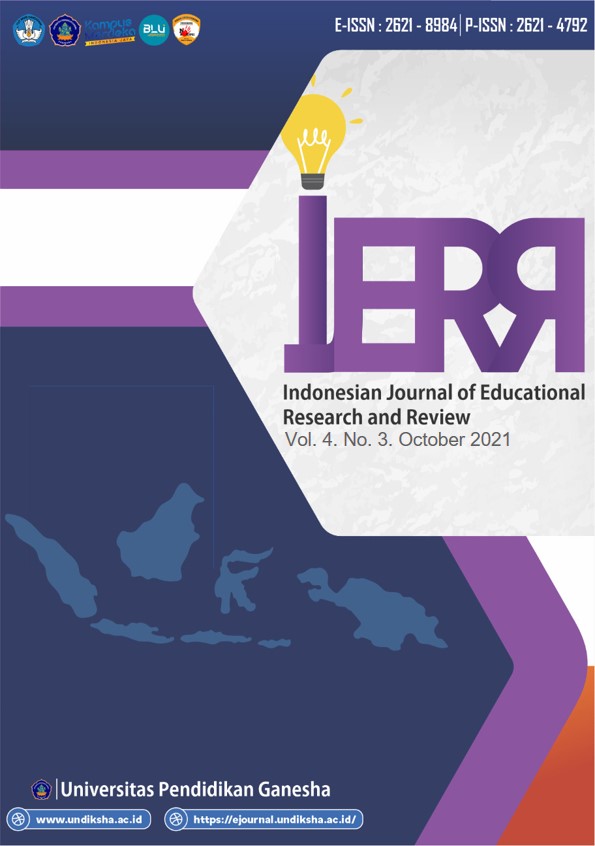Preparing Modified Bonding Representations Inventory: Challenges and Solution
DOI:
https://doi.org/10.23887/ijerr.v4i3.41639Keywords:
Use of MS-Excel in higher education, Standardization of Inventory, Modified Bonding Representation Inventory, Chemistry Education Research, Periodic Table and Ionic bondingAbstract
Collecting data on learners' performance in different chemistry contents and analysing them to identify their knowledge and understanding in related content areas is a major task of Chemistry Education Research. The data collection process on the learners' content knowledge and understanding of content knowledge requires a standard measuring tool. The preparation of standardized tools for measuring academic achievement requires computer software. All software used in the standardization of a tool comes at a cost and requires training for the researcher involved in handling the situation, which can impede the smooth running of a project. The same was the situation when the author was working on modifying the bonding representations inventory (BRI) for its local use in South Africa. The data analysis laboratory was situated in a different city, 500 km away from the researcher's field of work. Owing to the long distance and communication delay, the author was concerned with delays in the project. It is known that necessity, which can create an opportunity. The Microsoft Excel (MS-Excel) platform was used for standardizing the modified BRI because MS-Excel is available as a standard in MS-Office on the Windows platform. This paper presents a fact. That, a tool can be standardized by using MS-Excel without any complexity.
References
Beekman, A. T., Deeg, D. J. H., Van Limbeek, J., Braam, A. W., De Vries, M. Z., & Van Tilburg, W. (1997). Brief communication.: criterion validity of the Center for Epidemiologic Studies Depression scale (CES-D): results from a community-based sample of older subjects in the Netherlands. Psychological Medicine, 27(1), 231–235. https://doi.org/10.1017/S0033291796003510.
Cronbach, L. J., & Meehl, P. E. (1955). Construct validity in psychological tests. Psychological Bulletin, 52(4), 281. https://psycnet.apa.org/record/1956-03730-001.
Crooks, T. (2001). The validity of formative assessments. British Educational Research Association Annual Conference, University of Leeds, 13–15. http://www.leeds.ac.uk/educol/documents/00001862.doc.
Golafshani, N. (2003). Understanding reliability and validity in qualitative research. The Qualitative Report, 8(4), 597–607. https://core.ac.uk/download/pdf/51087041.pdf.
Hardesty, D. M., & Bearden, W. O. (2004). The use of expert judges in scale development: Implications for improving face validity of measures of unobservable construc. Journal of Business Research, 57(2), 98–107. https://doi.org/10.1016/S0148-2963(01)00295-8.
Jarvis, P. (2012). Towards a comprehensive theory of human learning. Routledge.
Kane, M. T. (1982). A sampling model for validity. Applied Psychological Measurement, 6(2), 125–160. https://doi.org/10.1177%2F014662168200600201.
Krause, S., Birk, J., Bauer, R., Jenkins, B., & Pavelich, M. J. (2004). Development, testing, and application of a chemistry concept inventory. 34th Annual Frontiers in Education.
Luxford, C. J., & Bretz, S. L. (2013). Moving beyond definitions: what student-generated models reveal about their understanding of covalent bonding and ionic bonding. Chemistry Education Research and Practice, 14(2), 214–222. https://doi.org/10.1039/C3RP20154F.
Nyachwaya, J. M., Mohamed, A. R., Roehrig, G. H., Wood, N. B., Kern, A. L., & Schneider, J. L. (2011). The development of an open-ended drawing tool: an alternative diagnostic tool for assessing students’ understanding of the particulate nature of matter. Chemistry Education Research and Practice, 12(2), 121–132. https://doi.org/10.1039/C1RP90017J.
Pellegrino, J. W., Chudowsky, N., & Glaser, R. (2001). Knowing what students know: The science and design of educational assessment. National Academy Press.
Smith, K. C., & Villarreal, S. (2015). Using animations in identifying general chemistry students’ misconceptions and evaluating their knowledge transfer relating to particle position in physical changes. Chemistry Education Research and Practice, 16(2), 273–282. https://doi.org/10.1039/C4RP00229F.
Suat, Ü. N. A. L., Coştu, B., & Alipaşa, A. Y. A. S. (2010). Secondary school students’ misconceptions of covalent bonding. Journal of Turkish Science Education, 7(2), 3–29. http://www.tused.org/index.php/tused/article/view/508.
Taber, K. S. (2011). Models, molecules and misconceptions: a commentary on “secondary school students’ misconceptions of covalent bonding. Journal of Turkish Science Education, 8(1), 3–18. http://www.tused.org/index.php/tused/article/view/342.
Tümay, H. (2016). Emergence, learning difficulties, and misconceptions in chemistry undergraduate students’ conceptualizations of acid strength. Science & Education, 25(1–2), 21–46. https://doi.org/10.1007/s11191-015-9799-x.
Vrabec, M., & Prokša, M. (2016). Identifying misconceptions related to chemical bonding concepts in the Slovak school system using the bonding representations inventory as a diagnostic tool. Journal of Chemical Education, 93(8), 1364–1370. https://doi.org/10.1021/acs.jchemed.5b00953.
Downloads
Published
How to Cite
Issue
Section
License
Authors who publish with the Indonesian Journal of Educational Research and Review (IJERR) agree to the following terms:
- Authors retain copyright and grant the journal the right of first publication with the work simultaneously licensed under a Creative Commons Attribution-ShareAlike 4.0 International License. that allows others to share the work with an acknowledgment of the work's authorship and initial publication in this journal.
- Authors are able to enter into separate, additional contractual arrangements for the non-exclusive distribution of the journal's published version of the work (e.g., post it to an institutional repository or publish it in a book), with an acknowledgment of its initial publication in this journal.
- Authors are permitted and encouraged to post their work online (e.g., in institutional repositories or on their website) prior to and during the submission process, as it can lead to productive exchanges, as well as earlier and greater citation of published work. (See The Effect of Open Access)









